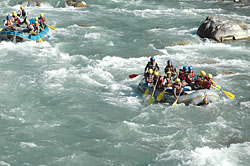|
|
| ROUGH RIDE: The Bhote Kosi is one of the most popular rivers for white-water rafting in the country. |
Outdoor adventure enthusiast Alex Teh, 24, travelled three hours by bus from Kathmandu and now stands on the pebbled bank of the Upper Sun Kosi, 40km south of the Tibetan border. Buckling his life jacket and donning a blue safety helmet, he is set to take on the rough waters of the fabled Bhote Kosi.
With only one weekend to spare for white-water rafting, the Singaporean tourist wanted a trip that would be short in time but not short on action. The Bhote Kosi lives up to the most daredevil expectations, and is close enough to Kathmandu to allow for short package trips.
But its days as a tourist destination may be numbered. Nepal's privately-owned Chilime Hydro Power Company has secured a license to build a dam on the middle stretch of the Bhote Kosi, which will submerge five of the river's 10 major rapids.
When news of the deal came out, villagers living both above and below the proposed dam site, as well as river and rafting organisations, scrambled to draw up a petition against it. They argued that the changes the dam will cause to the river will harm local livelihoods.
Rafting industry players say that about 20 to 30 percent of adventure tourists visiting Nepal come for rafting. "And a quarter of those go for the Bhote Kosi because it's a serious mountain river but easy to visit for just a couple of days," says Tej Bahadur, director of outdoor adventure company Mountain River Rafting.
The building of the dam has been delayed after the Nepal River Conservation Trust presented a petition against it in 2007, but the Trust's president Megh Ale says that the project is unlikely to have been shelved for good. Five other hydropower dams have already been constructed in Sindhupalchok district.
Despite conservation and local economic concerns, it is clear that Nepal needs electricity, and the country's 6000 rivers are a massive potential power source.According to Ale, the answer to meeting all the conflicting concerns is resource allocation. He says that most of Nepal's rivers rise above 6000m in altitude, and suggests that water below 1200m could be allocated to recreation and irrigation, leaving waters above that altitude available to hydropower.
But implementing such an arrangement is easier said than done, especially as hydropower developers and tourism promoters are also competing for locations which are easily accessible. The cost of building increases massively the further a site is away from the road.
The Bhote Kosi is one of the most contested flashpoints because it has both road accessibility on the Arniko Highway and, with an average gradient of 80ft per mile, a massive water force. For rafting, its rapids are classed from ranges three to five in intensity (six is the most intense). In hydropower terms, the swell is capable of producing at least 45MW of energy annually.
Energy specialist Bikash Pandey agrees that reconciling the demands of both the tourism and hydropower industries will be hard, but says the issue must be clearly resolved. "In California, tourism has produced much more revenue than hydro dams could. We should bear this in mind. But on the other hand we can't carry on with load-shedding like it is now," he says.
River entrepreneurs like Ale are hoping the new political climate in the country will prove favourable. "Building a new nation will require foresight and emphasis on sustainable development, and so does river management," he says. "The Bhote Kosi is the Everest of rafting. Just as the mountain, the river deserves protection and honour."



